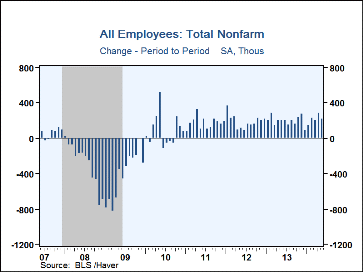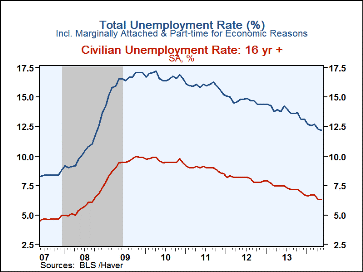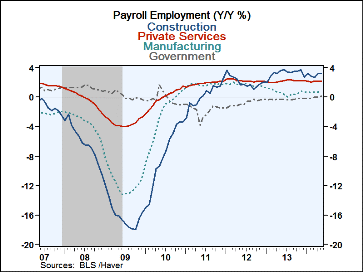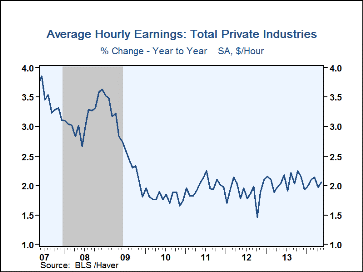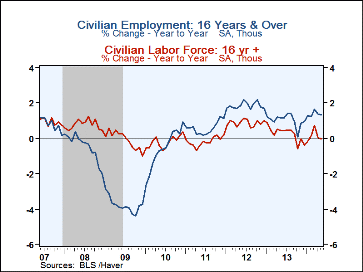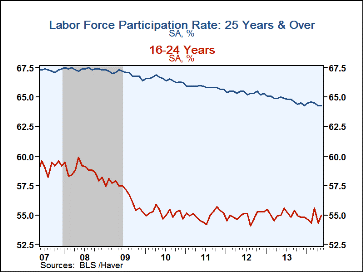 Global| Jun 06 2014
Global| Jun 06 2014U.S. Payroll Increase Moderates; Jobless Rate is Stable at Six-Year Low
by:Tom Moeller
|in:Economy in Brief
Summary
Nonfarm payrolls increased 217,000 during May following little-revised gains of 282,000 and 203,000 during the prior two months. A 220,000 increase had been expected in the Action Economics Forecast Survey. The unemployment rate [...]
Nonfarm payrolls increased 217,000 during May following little-revised gains of 282,000 and 203,000 during the prior two months. A 220,000 increase had been expected in the Action Economics Forecast Survey. The unemployment rate remained unchanged at 6.3%. An uptick to 6.4% had been expected. The overall unemployment rate, including marginally attached workers and those employed part-time for economic reasons, slipped to 12.2%.
From the establishment survey, the 217,000 gain in May payrolls returned the level of employment to its peak, reached in January 2008. The monthly increase reflected a marked slowdown in construction jobs. The slim 6,000 increase (3.2% y/y) was the weakest rise this year. Factory payrolls increased 10,000 (0.9% y/y), the firmest rise in three months.
Private service sector employment grew a firm 198,000 last month (2.1% y/y) following a 224,000 rise. The increase was led by a 63,000 gain (1.7% y/y) in education & health services. That was followed by professional & business service jobs which grew 55,000 (3.4% y/y). That included a 14,300 rise (8.5% y/y) in temporary help positions. Leisure & hospitality employment advanced 39,000 (2.8% y/y) while transportation & warehousing jobs improved 16,400 (2.8% y/y). Retail trade jobs grew 12,500 (2.1% y/y) and financial activities employment notched up 3,000 (0.6% y/y).
The length of the average workweek was stable m/m and y/y at 34.5 hours. It reflected a rebound in the manufacturing sector workweek to 41.1 hours, a record high. The length of the construction sector workweek slipped to 38.9 hours but private services rose minimally to 33.4 hours. Aggregate hours worked (employment times hours) improved 0.2% (2.1% y/y) following a 0.3% rise. So far in Q2, aggregate hours have risen 3.2% (AR) from Q1. During the last seven years there has been a 70% correlation between the change in aggregate hours and growth in real GDP.
Average hourly earnings improved 0.2% (2.1% y/y), the quickest gain since February. Earnings in the goods producing sector grew 0.2% (2.2% y/y) while private service sector earnings also rose 0.2% (2.0% y/y). Within services, information sector earnings slipped 0.1% (+3.5% y/y) but education & health earnings rose 0.1% (1.1% y/y). Professional business sector earnings grew 0.3% (2.2% y/y).
The household survey indicated that the unemployment rate remained stable at 6.3%, the lowest level since September 2008. The stability reflected a 145,000 increase (1.3% y/y) in employment and a 192,000 rise in the labor force, unchanged y/y. The labor force participation rate held at a low 62.8%, down from 67.1% averaged from 2007 to 2010. The number of potential workers who remained out of the labor force grew 2.5% y/y, just shy of the growth averaged since 2000. The 64.3% participation rate for those aged 25 and over compared to 67.4% during its peak five years ago. For individuals aged 16-24, the 54.3% rate compared to a 68.6% peak during 1989.
By educational attainment, the 8.9% unemployment rate for those with less than a high school diploma compared to 6.3% for graduates with no college. For individuals with some college or an associate degree, the jobless rate was 5.7% and for those with a bachelor's degree or more it was 3.3%.
The figures referenced above are available in Haver's USECON database. Additional detail can be found in the LABOR and in the EMPL databases. The expectation figures are from Action Economics and are in the AS1REPNA database.
The effect of labor slack on wages: Evidence from state-level relationships from the Federal Reserve Board is available here.
| Employment: (M/M Chg., 000s) | May | Apr | Mar | Y/Y | 2013 | 2012 | 2011 |
|---|---|---|---|---|---|---|---|
| Payroll Employment | 217 | 282 | 203 | 1.7% | 1.7% | 1.7% | 1.2% |
| Previous | -- | 288 | 203 | -- | -- | -- | -- |
| Manufacturing | 10 | 4 | 4 | 0.9 | 0.7 | 1.7 | 1.7 |
| Construction | 6 | 34 | 13 | 3.2 | 3.3 | 2.1 | 0.2 |
| Private Service Producing | 198 | 224 | 179 | 2.1 | 2.2 | 2.2 | 1.9 |
| Government | 1 | 12 | 3 | 0.1 | -0.3 | -0.8 | -1.8 |
| Average Weekly Hours - Private Sector | 34.5 | 34.5 | 34.5 | 34.5 (May'13) |
34.5 | 34.4 | 34.3 |
| Average Private Sector Hourly Earnings (%) | 0.2 | 0.0 | 0.1 | 2.1 | 2.1 | 1.9 | 2.0 |
| Unemployment Rate (%) | 6.3 | 6.3 | 6.7 | 7.5 (May'13) |
7.4 | 8.1 | 8.9 |
Tom Moeller
AuthorMore in Author Profile »Prior to joining Haver Analytics in 2000, Mr. Moeller worked as the Economist at Chancellor Capital Management from 1985 to 1999. There, he developed comprehensive economic forecasts and interpreted economic data for equity and fixed income portfolio managers. Also at Chancellor, Mr. Moeller worked as an equity analyst and was responsible for researching and rating companies in the economically sensitive automobile and housing industries for investment in Chancellor’s equity portfolio. Prior to joining Chancellor, Mr. Moeller was an Economist at Citibank from 1979 to 1984. He also analyzed pricing behavior in the metals industry for the Council on Wage and Price Stability in Washington, D.C. In 1999, Mr. Moeller received the award for most accurate forecast from the Forecasters' Club of New York. From 1990 to 1992 he was President of the New York Association for Business Economists. Mr. Moeller earned an M.B.A. in Finance from Fordham University, where he graduated in 1987. He holds a Bachelor of Arts in Economics from George Washington University.


